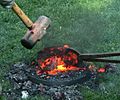Bloomery facts for kids
A bloomery was a special kind of furnace used a long time ago. It was one of the first ways people learned to get iron out of rocks that contained iron. This process is called smelting.
When you used a bloomery, you ended up with a lumpy mass of iron mixed with waste material called slag. This lumpy iron was called a "bloom." It looked a bit like a sponge because it had many tiny holes, so it was also known as sponge iron. This sponge iron was then usually hammered and shaped into wrought iron, which is a strong type of iron. Today, bloomeries are not used anymore because modern blast furnaces do a much better job.
How Did a Bloomery Work?
A bloomery was like a tall chimney. Its walls were made from strong materials that could handle a lot of heat, such as earth, clay, or stone. Near the bottom of the chimney, there were special pipes. These pipes, often made of clay or metal, went through the side walls. Their job was to let air blow into the furnace.
To use a bloomery, people would first put charcoal (which is like burnt wood) inside the chimney. Then, they would heat the charcoal until it was very hot. After that, they would add about the same amount of iron ore (the rock with iron in it). As the iron ore melted and mixed with other materials, it often created a substance called fayalite, which is a type of slag.
A Look Back: The History of Bloomeries
People started using iron around 1200 BC. This was a big step in human history!
Interestingly, it seems that China might have skipped using bloomeries for a long time. They seemed to go straight to using more advanced blast furnaces. However, some bloomeries have been found in China. Experts think these might have been brought from other places, rather than built there originally.
Bloomeries were used in parts of Africa, south of the Sahara Desert, even before 500 BC. This shows how early and widespread this technology was.
In Europe, the first bloomeries were quite small. They could only make about 1 kilogram (about 2.2 pounds) of iron each time they were used. But over many years, people learned to build bigger and better bloomeries. By the 1300s, a typical bloomery in Europe could smelt around 14 kilograms (about 30 pounds) of iron in one go!
Images for kids
-
Bloomery smelting during the Middle Ages, as depicted in the De Re Metallica by Georgius Agricola, 1556
-
A view of the bloomeries ('Catalan forges') at Mission San Juan Capistrano, the oldest (circa 1790s) existing facilities of their kind in California.
See also
 In Spanish: Horno bajo para niños
In Spanish: Horno bajo para niños







